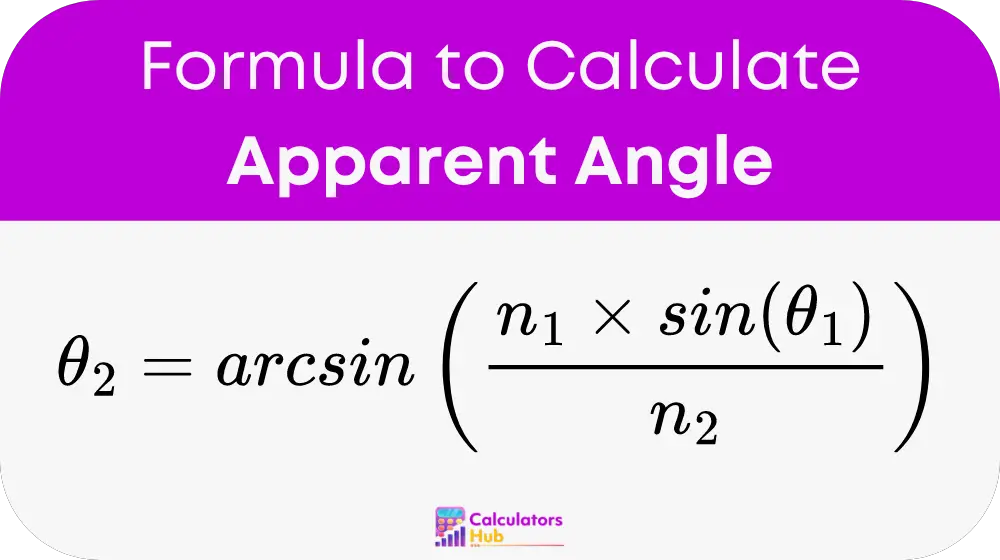The Apparent Angle Calculator is a specialized tool used primarily in physics and optical engineering to determine the angle of refraction, or the apparent angle, when light passes from one medium into another. This calculator is essential for designing lenses, understanding light behavior in different materials, and in educational settings where visualizing the impact of Snell’s Law enhances learning.
Formula for Apparent Angle Calculator
To compute the apparent angle, the calculator employs Snell’s Law, an equation fundamental to the study of optics. The formula used is:

Components of the Formula:
- theta_1: The angle of incidence, which is the angle at which light hits the interface between two media.
- theta_2: The angle of refraction, also known as the apparent angle, which is the angle at which light emerges in the second medium.
- n_1: The refractive index of the first medium.
- n_2: The refractive index of the second medium.
This formula allows users to calculate how significantly a light path will bend or refract when transitioning between materials of different optical densities.
Calculation Process:
- Input Data: Determine the angle of incidence and the refractive indices of the involved media.
- Apply Snell’s Law: Plug the values into the formula to find the angle of refraction.
- Interpret Results: Use the calculated angle to assess the optical behavior expected in practical applications, such as in lens design or optical instruments.
Practical Application: Reference Table
To facilitate understanding, here’s a hypothetical table demonstrating the refraction angles for light entering water from air at different incidence angles:
| Incident Angle (theta_1) | Refractive Index of Air (n_1) | Refractive Index of Water (n_2) | Refraction Angle (theta_2) |
|---|---|---|---|
| 0° | 1 | 1.33 | 0° |
| 30° | 1 | 1.33 | 22.09° |
| 45° | 1 | 1.33 | 32.08° |
| 60° | 1 | 1.33 | 40.51° |
This table helps visualize how the angle of incidence affects the angle of refraction, highlighting the practical impact of differing refractive indices.
Example of Apparent Angle Calculator
Consider a scenario where light enters water from air with an incident angle of 30 degrees:
- Incident Angle (theta_1): 30°
- Refractive Index of Air (n_1): 1
- Refractive Index of Water (n_2): 1.33
Using Snell’s Law:
- theta_2 = arcsin((1 * sin(30°)) / 1.33) = arcsin(0.5 / 1.33) ≈ 22.09°
This calculation shows that the light will refract to an angle of approximately 22.09 degrees within the water, demonstrating a significant bending effect due to the change in medium.
Most Common FAQs
Snell’s Law describes how light bends when it passes from one medium to another with a different refractive index. It is crucial for optical design and understanding various natural phenomena, such as rainbows.
The refractive index determines how much the light will bend when entering a new medium. A higher refractive index means that light will bend more towards the normal line perpendicular to the surface at the point of incidence.
While primarily used for light waves. Snell’s Law and the principles of refraction apply to other types of waves as well. Such as sound waves, under appropriate conditions.